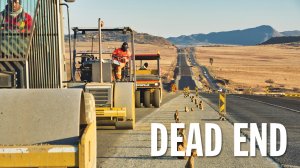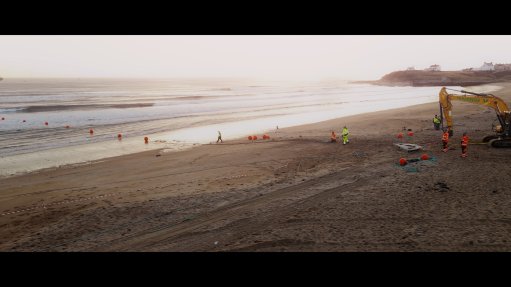‘Worst first’ road repair strategy no solution amid rapid deterioration
A lack of preventive maintenance is by far the biggest contributor to the deterioration of the South African road network, says South African National Roads Agency Limited (Sanral) engineering executive Louw Kannemeyer.
“It is purely because the infrastructure is not being maintained. And, because we don’t have a zero-maintenance design on our roads, we are seeing a rapid deterioration in the network.”
Kannemeyer adds that many South African roads are reaching the end of their design life, which means that they will be increasingly sensitive to a lack of maintenance.
South Africa has a proclaimed road network of more than 618 000 km.
Sanral is responsible for 22 262 km of the country’s roads at present. The agency’s network carries about 35% of yearly vehicle kilometres travelled in South Africa, but 70% of the long-distance road freight.
The rest of the country’s network falls under the ambit of provincial and municipal authorities.
It Doesn’t Pay to Do Nothing
Kannemeyer says there are two approaches to road maintenance.
The first is preventive maintenance. This is where Sanral, or a provincial or local authority, builds a road. Then, after seven to ten years, dependent on the climate and traffic, fine cracks develop, and the road surface must be waterproofed.
“To do that you need professionally qualified people,” says Kannemeyer. “You need engineers who understand what those cracks mean, who understand the climate of the area and the road design.”
If the relevant authority does not act to fix these cracks, secondary defects will likely develop after three to five years.
To repair the road will now cost six times more than what would have been the price tag to roll out the correct preventive maintenance, says Kannemeyer.
If left for five to eight years, fixing the road will now cost 18 times more, he notes.
“When a road is in a very poor condition, you don’t need to be an engineer to see that it’s in a poor condition,” says Kannemeyer.
“The reality we face is that a lot of authorities do not have professionals in their employ. The way [road] networks are currently being managed is to fix the worst first. [Authorities] wait for the road the most people complain about, and that is the one they’ll try and fix.”
However, following that strategy means that for every one kilometre of road repaired, the authority could have resealed 18 km of road, explains Kannemeyer.
“With the worst-first approach, the road cracks, and nothing gets done. Drains silt up, become blocked, and nothing gets done. The grass grows on the edge and it isn’t cut to allow the water to drain. Everybody then waits for potholes to develop.
“In the scenario of preventive maintenance, cracks are sealed, the grass is cut, the drains are cleaned – routine maintenance. That is a big focus area for Sanral.”
To cut grass and seal cracks cost about R9.50/m2 a year on average, says Kannemeyer.
“However, that buys you so much more in terms of asset life.”
Resealing costs are R70/m2 to R150/m2 every ten years.
To repair a pothole on a busy road is one of the most expensive exercises and can range from R700/m2 to R25 000/m2, says Kannemeyer.
The cost of accommodating traffic and closing lanes is ten times more than the actual repair work.
“You need to prevent the development of potholes at all costs – this is asset management,” says Kannemeyer. “And to do this, you need up-to-date data to ensure professionals can make informed decisions. At Sanral, we carefully track the deterioration of our roads.”
Cheaper Methods, so Maintenance Is Vital
When Sanral designs a road pavement, the agency does not design it for a number of calendar years, but rather for the traffic expected over the design period, which is typically 20 to 25 years.
Sanral will typically forecast the traffic over a 20-year period, says Kannemeyer, most notably the heavy-truck traffic.
This will determine the number of lanes – climbing lanes, passing lanes – and it will also dictate the kind of road pavement that will be constructed.
“What is really important to realise is that the South African design method is reliant on preventive maintenance being performed on that road during its life cycle for it to be able to achieve its design life,” emphasises Kannemeyer.
“This is very important to understand. We do not have a zero-maintenance design.”
Although all tarred road surfaces in South Africa may look the same, notes Kannemeyer, the difference lies below the surface, in the number of layers and the composition of these layers.
This is determined by the traffic expected to use the road over its design life, and this will also dictate construction costs.
Kannemeyer says it is important to know that South Africa does not have its own crude oil deposits, which also means that the country does not have its own bitumen to use in road construction.
“Over the years, we have minimised the use of bitumen, which means that our waterproof layers are very thin.”
South African roads tend to have 10 mm to 40 mm of waterproofing on the surface, while this is typically between 100 mm and 400 mm in the northern hemisphere.
“What this tells you is that our pavement is far more sensitive to a lack of maintenance than in the northern hemisphere,” says Kannemeyer.
So why not just use more bitumen?
With the South African road design method, some of the bitumen is substituted with natural gravels, which means that domestic roads are between 40% and 60% cheaper for the equivalent traffic and climate than a comparable road overseas, explains Kannemeyer.
“We have some of the best road design methods in the world, but the trade-off is that we have very thin waterproofing. If you don’t maintain it, water will get in and you will have rapid deterioration.”
Not Overloading, but Overuse
One of the reasons some South African roads are showing rapid deterioration relates to a sudden and unpredicted increase in traffic, and not overloading.
Traffic volume, or the anticipated number of axle repetitions over the design life of the pavement, will dictate the number and composition of layers in the road, as well as the quality of materials that will be used.
Normally, the better-quality materials will be at the top of the road structure, where the contact stresses are the highest.
While there is indeed 30% overloading on South African roads, the bulk of that is within the 5% grace tonnage offered, with government able to only prosecute 2.5% of overloading incidents.
Fleet operators are “very good” at calculating load distribution on trucks in order to optimise their loads, says Kannemeyer. Operators also make use of the grace tonnage, maximising their loads, as doing so leads to increased income.
It is, however, important to understand that the overloading of axles is not the major culprit in road deterioration, as is often widely publicised, but that it is rather the number of axle loads – how many trucks are actually moving over the road, says Kannemeyer.
For instance, consider the logistics concept of just-in-time (JIT), which did not yet exist when many of South Africa’s roads were designed and built.
According to JIT principles, businesses will move smaller loads more frequently, instead of keeping large inventories.
These loads are often not suited to the rail network, as they do not offer economies of scale, notes Kannemeyer.
All this means more trucks on the road.
“The global logistics chain has completely changed, and we can see this in the growth in the number of trucks over the last 20 years,” he adds.
Now also consider a road that was built with a forecast of 50 trucks a day, says Kannemeyer. This number means that the road was constructed in a certain manner, with an appropriately selected material composition.
A change in economic activity in the area, however, sees a sudden traffic jump in the corridor, and the number of trucks a day jumps to 1 000, as typically happens when mining is unlocked in a rural town.
“For 1 000 trucks, you need a very different pavement,” says Kannemeyer.
“The life of that pavement that I originally designed for 20 years for 50 trucks a day – if that jumps to 1 000 – the 20-year life of that pavement drops to one year.
“That is a reality we are seeing out there. We suddenly see trucks on roads that were never designed for those truck loads, that number of truck axles, or that number of trucks.”
One such road is the N10, where manganese mining and exports have seen the number of trucks increase from 200 a day to more than 1 000.
Kannemeyer says South Africa’s lower- order roads are typically heavily impacted on by a change in traffic, while higher-order roads, like the N3 between Johannesburg and Durban, have been built to handle a wider margin of traffic increases.
Role of Tyres and Climate Change
There have been significant changes in the way trucks are operated – including in South Africa – as part of the continuous effort to reduce operating costs, says Kannemeyer.
One of the developments that have had a significant negative impact on roads in the country was the move from cross-ply truck tyres to radial truck tyres.
This change-over shrunk the contact footprint of the tyre with the road surface, thereby reducing rolling resistance and increasing fuel efficiency by about 30%, says Kannemeyer.
The challenge, however, is that the same axle load is now carried over a smaller tyre footprint, which substantially increases contact stresses at the road surface.
This technology, which manifests as stronger, smaller, highly inflated tyres, typically leads to the rutting often seen on roads, especially during hot, dry seasons.
“We went through a major effort to recalibrate our design models to be able to allow for this technology,” says Kannemeyer.
Climate also plays a significant role when it comes to road maintenance, he adds.
The deterioration of the road network is heavily influenced by where you are in the country. Typically, wetter areas have higher economic activity, and therefore higher traffic loads.
On average, the traffic in KwaZulu-Natal is 16 times higher than in the Northern Cape, says Kannemeyer.
Compared with KwaZulu-Natal roads, the Northern Cape roads are, therefore, made of more marginal materials.
This means that a lack of preventive maintenance will immediately reflect in higher- moisture areas, such as Mpumalanga and KwaZulu-Natal, compared with lower- moisture areas.
End of the Road
Another major challenge South African roads face is pavement age, says Kannemeyer.
Currently, 83.6% of the network under Sanral’s jurisdiction is older than its 20-year theoretical design life, with the same true for provincial and municipal roads, he notes.
“For some provinces, the latest information we have available indicates that 66% to 68% of their surface network is in a poor to very poor condition.”
For Sanral’s roads, however, this number is 7.11%, owing to its preventive maintenance strategy, which is within the international norm of 10%.
“The national road network is at the end of its life and thus very sensitive to any adverse changes in the number of axles, axle loads, rainfall and lack of preventive maintenance,” says Kannemeyer.
“Our challenge in our country is that, if our road network is not properly looked after, potholes will develop everywhere after one or two weeks of prolonged rain, which means that a diligent maintenance strategy is of vital importance.”
• Kannemeyer spoke at a Transport Forum event.
Article Enquiry
Email Article
Save Article
Feedback
To advertise email advertising@creamermedia.co.za or click here
Comments
Press Office
Announcements
What's On
Subscribe to improve your user experience...
Option 1 (equivalent of R125 a month):
Receive a weekly copy of Creamer Media's Engineering News & Mining Weekly magazine
(print copy for those in South Africa and e-magazine for those outside of South Africa)
Receive daily email newsletters
Access to full search results
Access archive of magazine back copies
Access to Projects in Progress
Access to ONE Research Report of your choice in PDF format
Option 2 (equivalent of R375 a month):
All benefits from Option 1
PLUS
Access to Creamer Media's Research Channel Africa for ALL Research Reports, in PDF format, on various industrial and mining sectors
including Electricity; Water; Energy Transition; Hydrogen; Roads, Rail and Ports; Coal; Gold; Platinum; Battery Metals; etc.
Already a subscriber?
Forgotten your password?
Receive weekly copy of Creamer Media's Engineering News & Mining Weekly magazine (print copy for those in South Africa and e-magazine for those outside of South Africa)
➕
Recieve daily email newsletters
➕
Access to full search results
➕
Access archive of magazine back copies
➕
Access to Projects in Progress
➕
Access to ONE Research Report of your choice in PDF format
RESEARCH CHANNEL AFRICA
R4500 (equivalent of R375 a month)
SUBSCRIBEAll benefits from Option 1
➕
Access to Creamer Media's Research Channel Africa for ALL Research Reports on various industrial and mining sectors, in PDF format, including on:
Electricity
➕
Water
➕
Energy Transition
➕
Hydrogen
➕
Roads, Rail and Ports
➕
Coal
➕
Gold
➕
Platinum
➕
Battery Metals
➕
etc.
Receive all benefits from Option 1 or Option 2 delivered to numerous people at your company
➕
Multiple User names and Passwords for simultaneous log-ins
➕
Intranet integration access to all in your organisation





















